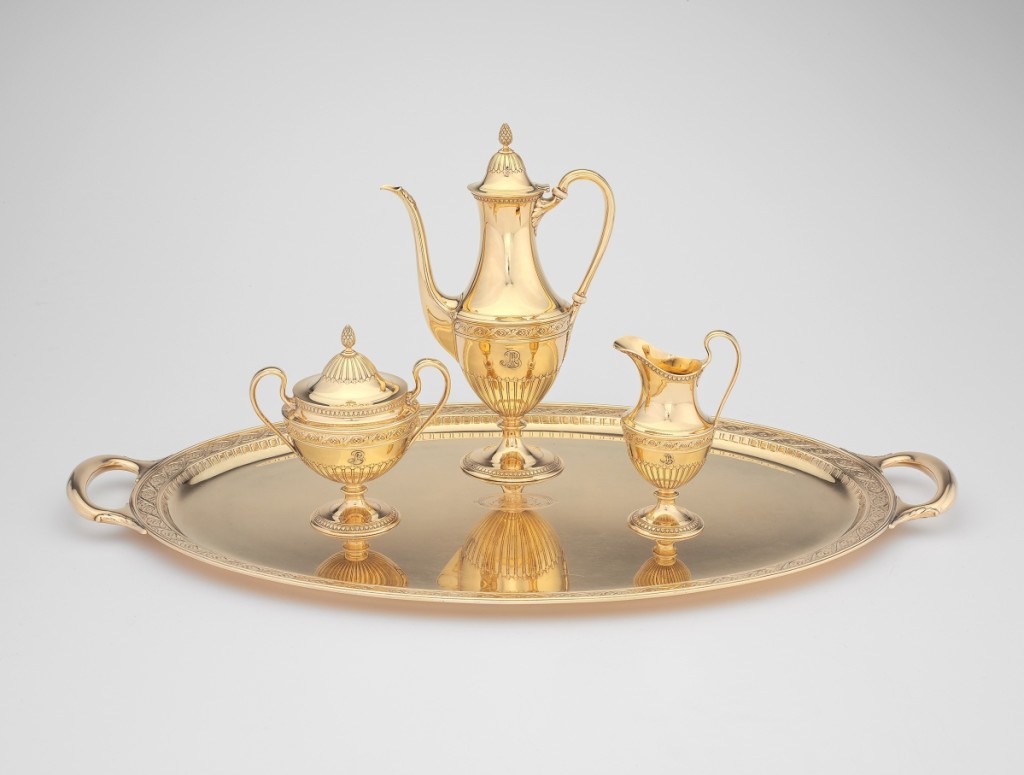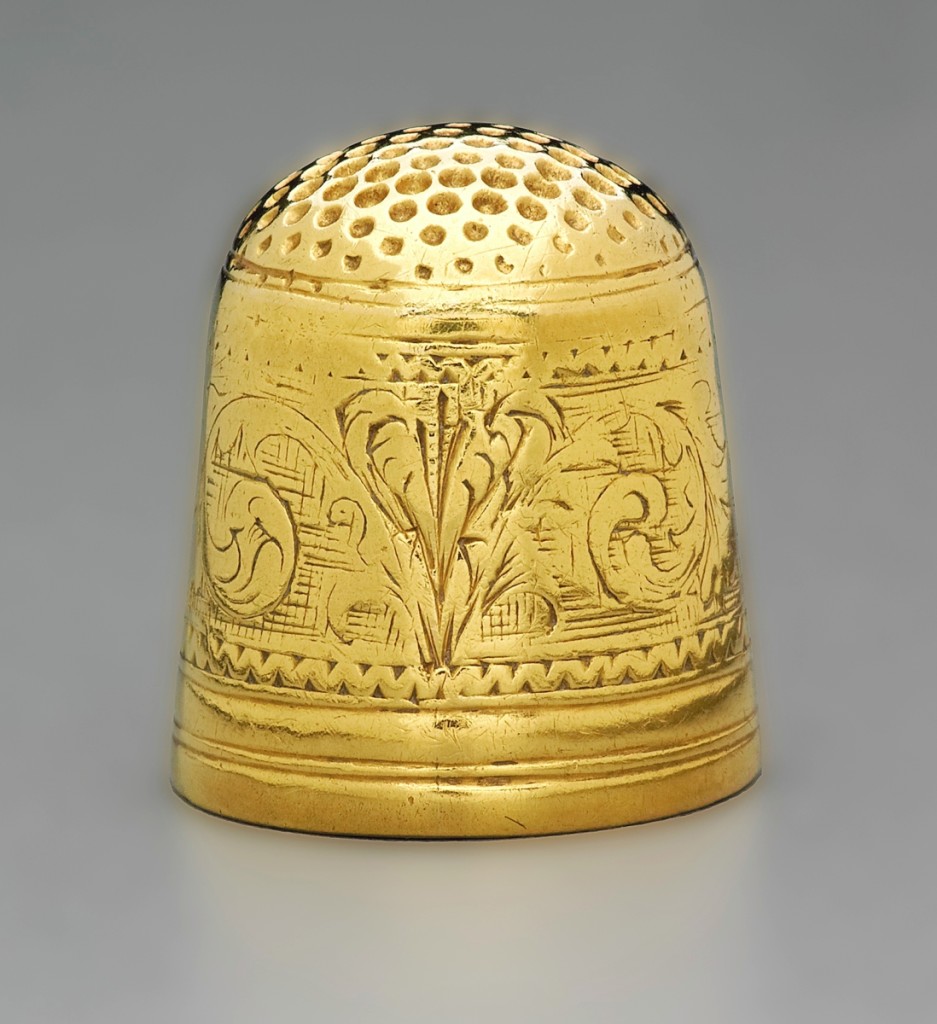-1024x565.jpg)
An 1852 gold “50 Dollars,” George Albert Ferdinand Kuner, die cutter; Augustus G. Humbert, assayer; and United States Assay Office of Gold, mint, San Francisco. Yale University Art Gallery, gift of Meryl Blau Menon, m.a.t. 1961, in honor of her parents, Abram and Anna Blau.
By Laura Beach
NEW HAVEN, CONN. – Calling oneself a “storyteller” is fashionable among creative people of all stripes these days. Compelling narratives, after all, engage audiences. Few curators do so more persuasively than John Stuart Gordon. The Benjamin Attmore Hewitt curator of American Decorative Arts at Yale University Art Gallery (YUAG) has a talent for identifying the emotional heart of objects and for tracing their mutable, often contradictory, meanings over time.
“Gold in America: Artistry, Memory, Power,” on view at YUAG from February 25 through July 10, is successful even at a purely visceral level. (To check current Covid-19 policies, open times and remote programs, visit https://artgallery.yale.edu). The roughly 70 examples of post-contact American gold and related paintings, photographs and other works of art are, to put it mildly, gorgeous. But Gordon takes his subject beyond the superficial to explore the metal’s social magnetism. From the Oscars to the Olympics and beyond, gold is the standard by which much human endeavor is measured.
American gold was a topic Gordon had long contemplated. The most important prior exhibition on the subject, also at Yale, produced the slim but valuable catalog American Gold, 1700-1860 by Peter J. Bohan, published by YUAG in 1963. “The exhibition was a landmark. I was intrigued and genuinely surprised that no one had revisited the topic. So much has changed since 1963 in our approaches, our resources, in how we think about objects and in our collection. I wanted to bring everything up to the present,” Gordon said recently by phone.
“I’d envisioned a large exhibition with many loans, as well as a show that might travel. When Covid struck, I had the opportunity to do a smaller show, one drawn mostly from the university’s own collections. Yale’s holdings of American gold are unsurpassed. There are few places where an exhibition of this caliber could be assembled with very little borrowing,” the curator explained.
Gordon began his search by identifying nearly 293 objects in Yale’s possession. He recalls, “The proportion of objects with known histories of both maker and owner was remarkably high. Many have inscriptions, monograms or dedications. I started asking why. Gold is intrinsically valuable, but also emotionally valuable. These objects were treasured and therefore their histories tended to be recorded. That these objects had double lives as containers of emotion and history really became the defining idea behind the exhibition.”
-937x1024.jpg)
“forsakengardenheart” by Lola Brooks, Brooklyn, 2012. Stainless steel, 14K gold, ivory, coral and 14K solder. Yale University Art Gallery, Janet and Simeon Braguin Fund. ©Lola Brooks.
The pieces on view span more than three centuries, ranging in date from about 1700 to 2017. Ancient gold – considered in, among others, the joint Metropolitan Museum of Art-J. Paul Getty Museum exhibition “Golden Kingdoms: Luxury and Legacy in the Ancient Americas” of 2017-2018 – is largely left to others. At YUAG, a small introductory section on the sources of gold produces such curiosities as a nugget of gold ore mined in, of all places, North Carolina in the 1840s and a 1795 gold coin from Potosi in Bolivia.
While Europeans exploited Latin America for its gold – and North American colonists, Gordon writes, took an avid interest in gold’s discovery globally – it is the Caribbean that most interests the curator. He says, “Let’s be upfront: if you were a wealthy American in the Eighteenth Century, your wealth probably originated in the Caribbean trade. When you are looking at these objects, you need to remember that they are part of a very iniquitous society. While every sugar bowl may be somehow complicit in the slave trade, I wanted to take that story a step further and find the one-on-one connections.”
Making his point, Gordon included a skimmer spoon and eight teaspoons – part of the only gold flatware service surviving from the American colonies – made by the Huguenot silversmith Simeon Soumaine (baptized 1685-circa 1750) of New York around 1720-30. The implements appear to have been owned by the Barbados-born Hugh Hall (1693-1773), who continued to profit from the slave trade after moving to Boston. Gordon examined Hall’s 1729 account book, which survives in part at the Massachusetts Historical Society, where he found recorded the names of 70 enslaved people sold by the merchant.
A variety of trades contributed to gold as adornment for body and home. Gordon digs into the subject of ornamental gilding, focusing on John Singleton Copley’s 1769 portrait of the Boston merchant Isaac Smith (1719-1787). The painting is still housed in its original frame, probably carved by John Welch (1711-1789) and gilded by Stephen Whiting (1720-1789), a Boston craftsman with documented links to both Copley and Welch.
Gold often commemorates life’s great private milestones. “We are living with traditions that are centuries old,” says the curator, who arrayed mementos of birth, love, courtship and death. The artifacts range from a set of whistle-and-bells by Daniel Christian Fueter (1720-1785), given by Mary Livingston to her infant granddaughter around 1761, to a gold-encased watercolor-on-ivory memorial to Solomon and Joseph Hays of 1801. “There is symbolic weight to this material, which is always shiny, hard and durable. Gold reminds us of qualities we value,” Gordon says.

Coffee service for Alice Belin du Pont, Tiffany and Company, New York, designed 1910–11. 18K gold. Yale University Art Gallery, gift of G. d’Andelot Belin, b.a. 1939.
In the public sphere, gold has been used to reward success and acknowledge power. To that point, Gordon displays together for the first time since the 1940s Ralph Earl’s (1751-1801) circa 1786 portrait of Major General Friedrich Wilhelm Augustus (1730-1794), known as the Baron von Steuben; his silver-hilted dress sword, long in Yale’s collection but only recently identified by Gordon; a Society of the Cincinnati medal resembling one owned by the baron, a Prussian-born Revolutionary War officer and Washington confidante; and his gold Freedom Box, made by Samuel Johnson (1726-1796), engraved by Peter Rushton Maverick (1755-1811) and awarded to the baron in 1784 by the City of New York, which gave a similar commemorative box to John Jay. Jay’s box, owned by the collectors Richard and Maureen Chilton, is a promised gift to the Metropolitan Museum of Art.
Von Steuben’s story is an interesting one. He lived with Major William North, his former aide-de-camp and adopted heir, leading to contemporary speculation that he was gay, a question Gordon confronts directly. Earl’s portrait, along with his silver-hilted dress sword and Freedom Box, descended to North. In 1929, heirs put them up for sale at the American Art Association, where Knoedler purchased the portrait for William Randolph Hearst, and Yale benefactor Francis P. Garvan acquired the box and dress sword.
“The Freedom Box of New York is emulating old European civic traditions, recreating aspects of society known from across the Atlantic. As a civic act it is quite extraordinary,” the curator says.
Another object with an intriguing backstory is a gold thimble made between 1730 and 1740 by Boston silversmith Jacob Hurd (1702-1758). It was owned by Elizabeth Gooch Hubbert (1698-1768), who after the death of her first husband built a successful business as a seller of imported laces and trims. She later married John Franklin, postmaster of Boston and the older brother Benjamin Franklin. Although the thimble has long been associated with the Franklin family, its true import is as a rare symbol of female agency in the early Eighteenth Century.

Thimble owned by Elizabeth Gooch Hubbart Franklin by Jacob Hurd, Boston, 1730-40. Gold. Yale University Art Gallery, Mabel Brady Garvan Collection.
“It’s not truly practical for sewing – gold is a soft medal – but it relates to Elizabeth’s line of work. This young widow made enough money to acquire a gold object. To bring a new life to an object like this is very rewarding,” the curator says.
The discovery of gold in California in 1848 transformed the United States, driving its population westward, adding to its cultural diversity and stimulating new enterprise. Rare gold samples, coins struck in Colorado and California, and an 1849 spoon from San Francisco tell the story. Samuel H. Ward, a 32-year-old entrepreneur, proudly sent the spoon home to his mother in Middletown, Conn., as proof of his success. It is marked by the assay company Moffat & Co., in which Ward was a partner.
The exhibition references the Gilded Age, a term coined by authors Mark Twain and Charles Dudley Warner to describe the opulent last decades of the Nineteenth Century. The era’s expansive mood is reflected by a gold coffee service manufactured by Tiffany and Company in 1915 and owned by Alice Belin, who married Pierre S. du Pont, the future president of E.I. du Pont de Nemours and Company.
Gordon relays new scholarship on a $5 coin minted in Philadelphia in 1908. Designed by Bela Lyon Pratt, it is embellished with the portrait of a Brule Lakota chief believed to be Hollow Horn Bear (Matho Hehlogeca), only recently been identified by name.
Minted in Philadelphia in 1911, a $20 coin designed by Augustus Saint-Gaudens features a Goddess of Liberty, a smaller version of the figure depicted on the Sherman Memorial in New York City, for whom the African American model Hettie Anderson served as inspiration.
“This is a moment when President Roosevelt is tapping the foremost American sculptors to create gold coinage, which really elevated the artform. Roosevelt endorsed racist policies, yet he also produced one of the first depictions of a Black woman on an American coin and the first depiction of a known Native American on an American coin. One fact doesn’t erase the other, but they underscore the complexities and the contradictions that emerge when one studies the past,” Gordon says.
-1024x983.jpg)
Memorial for Solomon and Joseph Hays, probably New York, 1801. Watercolor, pearls, gold wire, beads and hair (natural, chopped and dissolved) on ivory. Yale University Art Gallery, promised bequest of Davida Tenenbaum Deutsch and Alvin Deutsch, ll.b. 1958, in honor of Kathleen Luhrs.
The exhibition ends on a provocative note, exploring the freighted meaning of gold in contemporary life. Here we find a circa 1975 gold cuff by Hopi artist Charles Loloma (1921-1991), who upended Native American jewelry traditions with his pioneering use of gold and stones not typical in Hopi metalwork; mixed-media sculpture by Brooklyn artist Lola Brooks, who probes the dark side of conventional love tokens, “conflict” minerals and endangered materials such as ivory and coral; and Victoria Sambunaris’ untitled photograph of a gold mine, beautiful only from a distance.
Small but luxurious, “Gold in America” fills one gallery, encompassing several cases and lining adjacent walls. Gold gleams against a dark-blue backdrop, inviting visitors to draw near, where magnifying glasses encourage closer inspection.
Gordon will lecture on the exhibition virtually on Thursday, February 24. He is also planning an online series of lectures and conversations between scholars and makers. The details of those are still pending updates to Yale’s visitor and events policies.
Lost, stolen or melted down, gold artifacts are scarce. Gordon writes that, apart from coinage, there are fewer than 200 known pieces signed or marked by early American craftsmen. Happily, “Gold in America” arrays some of the best of these rare treasures, making for a lustrous statement of what we most value.
The Yale University Art Gallery is at 1111 Chapel Street. For information, or to confirm opening hours or current health policies, www.artgallery.yale.edu or 203-432-0600.








.jpg)

.jpg)
.jpg)




